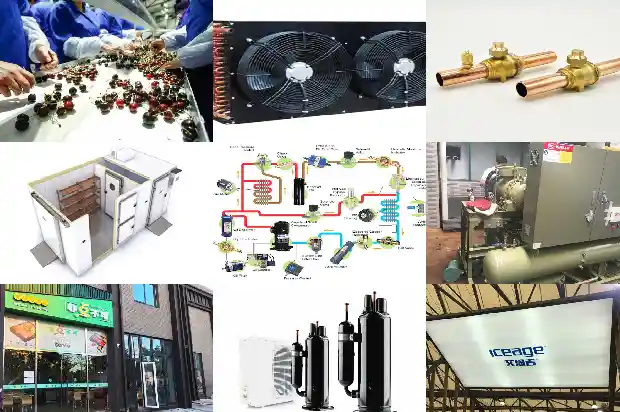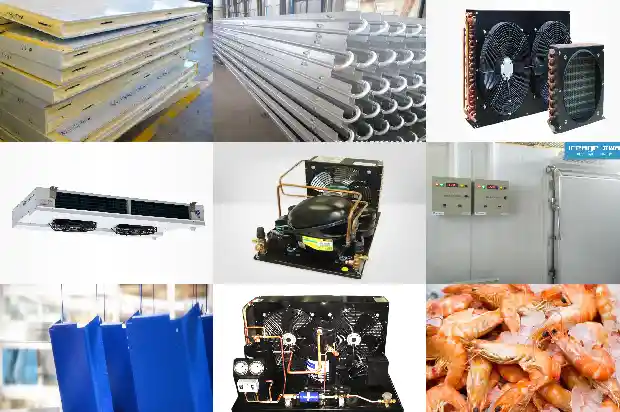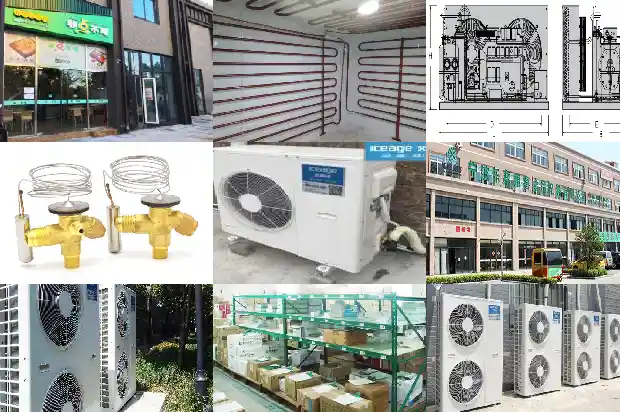Analysis and Treatment of Common Low Pressure Faults in Chillers
2024-09-09
There are many factors that cause low-pressure failures in chillers (freezers). Today we only list some of them. They can be roughly divided into the following categories (sorted from easy to difficult): system leakage, system blockage, and evaporator blockage.
Fault One: System Leakage
There are leakage points in the connection pipes of the refrigeration system, such as welding problems, corrosion problems caused by the environment, fractures caused by mechanical vibration, and human factors.
Treatment: This kind of problem is relatively simple to deal with. First, use leak detection fluid (soapy water or detergent water) or a halogen leak detector to find the leakage point. When the leakage point is found, use welding equipment to weld it. After necessary vacuum treatment, refill the refrigerant according to the amount specified by the manufacturer, and the equipment can be restored to operation.
There are leakage points in the connection pipes of the refrigeration system, such as welding problems, corrosion problems caused by the environment, fractures caused by mechanical vibration, and human factors.
Treatment: This kind of problem is relatively simple to deal with. First, use leak detection fluid (soapy water or detergent water) or a halogen leak detector to find the leakage point. When the leakage point is found, use welding equipment to weld it. After necessary vacuum treatment, refill the refrigerant according to the amount specified by the manufacturer, and the equipment can be restored to operation.
Fault Two: System Blockage
There are four reasons for the blockage of the refrigeration system:
Debris blockage;
Ice cubes;
The solenoid valve is broken;
The expansion valve is broken.
There are four reasons for the blockage of the refrigeration system:
Debris blockage;
Ice cubes;
The solenoid valve is broken;
The expansion valve is broken.

- Debris blockage:
Because the refrigeration system has strict requirements in all aspects of production and manufacturing, it is necessary to ensure the cleanliness of each link. However, most chiller (freezer) manufacturers purchase parts and assemble them. This will inevitably lead to some impure systems. In severe cases, the system will be blocked. (Generally, the blockage occurs at the filter or the inlet of the expansion valve.) Therefore, the manufacturer of the chiller installs a "filter" in the refrigeration system to filter out impurities in the system. When the impurities in the pipeline of the refrigeration system accumulate to a certain extent, the filter will be blocked, affecting the passing amount of the refrigerant in the system, and a low-pressure failure will occur in severe cases.
Identification: If the filter is blocked due to a dirty system, it will only lead to a decrease in the cooling capacity of the equipment, and you may not even be affected. When the "filter" is slightly blocked, there is a temperature difference between the inlet and outlet of the "filter", which can be felt by hand at the inlet and outlet. In severe cases, condensation or frosting may occur on the filter. If the filter is found to have condensation or frosting (condensation does not occur when the machine is running, and condensation is not counted).
Treatment: Replace the filter of the same model.
- Ice cubes:
Ice blockage is mainly due to the presence of moisture in the system pipes. The moisture in the system flows to the throttle valve (expansion valve) along with the refrigerant after throttling and expansion. A low temperature and low pressure are formed at the outlet of the throttle valve. When the evaporation temperature (throttle) valve is lower than the freezing point, the moisture in the refrigerant will form ice cubes here, thereby preventing the throttle valve (expansion valve) from forming a low-pressure failure. Ice blockage occurs at the outlet of the throttle valve (expansion valve).
Treatment method: First, use a detachable filter with "calcium chloride" (a strong water-absorbing material) to thoroughly filter the moisture in the system, and replace it with a disposable filter of the same model. - Solenoid valve:
The solenoid valve is an indispensable accessory in the refrigeration system. It has the function of protecting the safety of the system. (When the compressor stops working, the refrigerant is cut off, and the refrigerant is not allowed to continue to flow to the evaporator. If there is a large amount of refrigerant in the compressor evaporator, when the compressor is started again next time, it is easy to cause liquid accumulation in the compressor valve and damage the compressor). When the solenoid valve is damaged, the refrigerant circulation is blocked, resulting in a low-pressure failure. At present, most manufacturers omit the solenoid valve in order to reduce costs, but this also leaves hidden dangers for the equipment.
Identification: The solenoid valve is relatively easy to judge. There are two cases when the solenoid valve is broken: - The solenoid valve coil is burned out, and the diaphragm cannot be opened. The solenoid valve coil can be measured with a multimeter to determine whether the solenoid valve is burned out;
- The solenoid valve body itself is damaged, resulting in the inability to open the inner membrane of the valve. When there is a temperature difference between the inlet and outlet of the solenoid valve, it indicates that the solenoid valve is faulty.
- Expansion valve damage:
The expansion valve is one of the four major components of the refrigeration system and is an indispensable component. The low-temperature and high-pressure refrigerant after condensation flows through the expansion valve, is throttled by the expansion valve, expands and evaporates at the outlet of the expansion valve, and forms a low-temperature and low-pressure gas-liquid mixed refrigerant, thereby taking away the heat in the system and forming a refrigeration process.
There are mechanical expansion valves and electronic expansion valves. The mechanical expansion valve is affected by the environment during use. Some environments have corrosive gases and corrosive liquids, which cause the expansion valve to corrode. Mostly, the temperature sensing package of the expansion valve leaks gas (the connecting pipe connecting the temperature sensing package and the valve body is corroded). Although the electronic expansion valve has the advantages of a large temperature control range and high precision that the mechanical expansion valve cannot surpass, its independent control system also virtually increases the failure rate.
Treatment: If the expansion valve is damaged, it can only be replaced.
Fault Three: Seriously Insufficient Heat Exchange Capacity of the Evaporator
There are two reasons for insufficient heat exchange in the evaporator: a. Insufficient water flow in the evaporator; b. Foreign matter blocking in the evaporator (or scaling on the surface of the evaporation tube in the evaporator, or crystallization due to insufficient heat generation of the evaporator)
There are two reasons for insufficient heat exchange in the evaporator: a. Insufficient water flow in the evaporator; b. Foreign matter blocking in the evaporator (or scaling on the surface of the evaporation tube in the evaporator, or crystallization due to insufficient heat generation of the evaporator)
- Insufficient water flow in the evaporator:
The main factors causing this phenomenon are pump failure or foreign matter entering the pump impeller, or air leakage in the inlet pipe (it is difficult to check and requires careful analysis), resulting in insufficient water flow.
Treatment: Replace the pump, or disassemble the pump, remove the foreign matter in the impeller, and eliminate the fault. - Evaporator blockage or scaling:
To determine whether the evaporator is blocked or the evaporation tube is scaled, first rule out the pump problem and ensure that the pump and inlet pipeline are normal. Evaporator blockage or scaling has a common and very obvious feature (only for medium-temperature units): when the equipment is normal, there will not be a large amount of condensed water or frost on the surface of the compressor. When a large amount of condensed water or frost is seen on the surface of the compressor, it can be basically determined that the evaporator is blocked.
Treatment method: If the evaporator is blocked or the evaporation tube is scaled, the evaporator should be disassembled, and the evaporation tube should be discharged with a high-pressure water gun or soaked in a special liquid.
Note: Some evaporators are chemical liquids, such as the refrigerators in aluminum oxidation (anodizing) processing plants. The evaporator contains sulfuric acid solution. When certain conditions are met, sulfuric acid will crystallize and agglomerate. For the evaporator, if it is blocked by pure sulfuric acid crystallization, it can be dissolved by circulating hot water above 50 degrees Celsius in the evaporator. Others are used in electroplating plants, such as acid zinc plating. Some acid zinc plating solutions contain "potassium chloride". When the liquid containing "potassium chloride" passes through the surface of the evaporation tube of the evaporator, the surface temperature of the evaporation tube is very low (lower than the saturation temperature), which may cause "potassium chloride" to precipitate and crystallize. The accumulation of these crystals covers the evaporation tube with a thick layer of "potassium chloride" coating, making the evaporator lose its heat exchange capacity.
Slight performance is a decrease in cooling capacity, and a low-pressure failure occurs in severe cases. (This is the case when purchasing is incorrect).
Important reminder: After dealing with each fault point, the "reset button" on the pressure controller must be pressed. The common low-pressure fault analysis and treatment are also applicable to other types of refrigeration units.
Related Articles
- Analysis of Seven Reasons for Ice Formation in Computer Room Air Conditioners
- Analysis and Troubleshooting of Common Faults in Air - source Heat Pumps
- Analysis of 6 Components in Air - cooled Multi - split Systems
- Analysis of Advantages, Disadvantages and 34 Common Components of Multi - split Air Conditioners
- Common Causes and Analysis of High and Low Pressure Alarms
- Common Causes and Analysis of Compressor Thermal Protection
- Analysis of Common Faults in Compressor Overcurrent and Burnout
- Analysis of Causes for Safety Valve Leakage
- Analysis of Refrigeration Compressor Motor Faults
- Fault Analysis of Working Principle of Screw Chiller Unit
- Analysis and Treatment of Common Low-Pressure Faults in Chillers
- Water Cooled Unit Principle of Operation and Parameter Failure Analysis
- Common Operating Faults and Treatment Methods of Centrifugal Compressors
- How does an industrial water chiller operate when it is used for water treatment?
- Freezing Chamber System Blockage, Dirty Blockage, and Oil Blockage Characteristics and Treatment Methods
- Winter Approaches: How to Solve the Low High - pressure Issue of Air - cooled Condensing Units?
- Common Pressure Valves and Protection Devices in Refrigeration Units
- How to Troubleshoot and Repair High - pressure Protection of Air - cooled Units?
